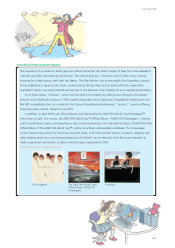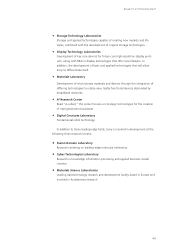Sony 2002 Annual Report Download - page 52
Download and view the complete annual report
Please find page 52 of the 2002 Sony annual report below. You can navigate through the pages in the report by either clicking on the pages listed below, or by using the keyword search tool below to find specific information within the annual report.50
Sony Corporation Annual Report 2002
Joint Development of Advanced Semiconductor Process Technology
In April 2002, Sony and Sony Computer Entertainment (SCE) signed an agreement
with Toshiba Corporation and IBM Corporation to cooperate in the field of ad-
vanced semiconductor process technology.
The objective of this alliance is to develop high-performance, low-power
consumption system chips required by an extensive range of applications used in
products from digital consumer electronics to supercomputers. The four companies,
which include both Sony Corporation and SCE, plan to develop leading process
technologies for fabricating semiconductor devices featuring 50 nanometers on
300mm wafers. The unprecedented circuit density that results will enable single
chips to incorporate an enormous number of transistors and other functional
elements. This technology will lead to system-on-chip (SoC) designs, in which a
single chip integrates processing, memory, communications, and other functions
that are currently performed by separate chips.
Although Sony is a leader in the electronics and game markets, by being involved
in this alliance, Sony can accelerate the development of high-performance, low-power
consumption system chips. As a result, we believe that incorporating these chips into
Sony’s digital electronic and computer entertainment products will allow the company
to further strengthen its competitiveness.
Blue-Violet Laser
Sony has developed a gallium arsenide blue-violet laser diode, towards the creation
of large-capacity optical recording and playback devices, as significant demand is
expected for such devices in the broadband network era. The new laser is essential
to the commercialization of the Blu-ray Disc, a large-capacity optical disc video
recording format established in February 2002. The foundations for this achieve-
ment were laid in April 1999, when Sony’s Central Research Center assigned a team
of engineers to work at Sony Shiroishi Semiconductor Inc., where red laser diodes
are produced, to speed up the development of the new laser. Sony is preparing itself
for the spread of next-generation, high-capacity optical discs.
Additionally, Sony has developed a multi-beam structure for blue-violet lasers
and a technique to form them into arrays which make blue-violet lasers suitable
for displays and a variety of other industrial applications. Work has been com-
pleted on a prototype of an ultra-high-output blue-violet laser diode having a
continuous light power output in the 4.2W range, the highest in the world for
405-nanometer wavelength.
























